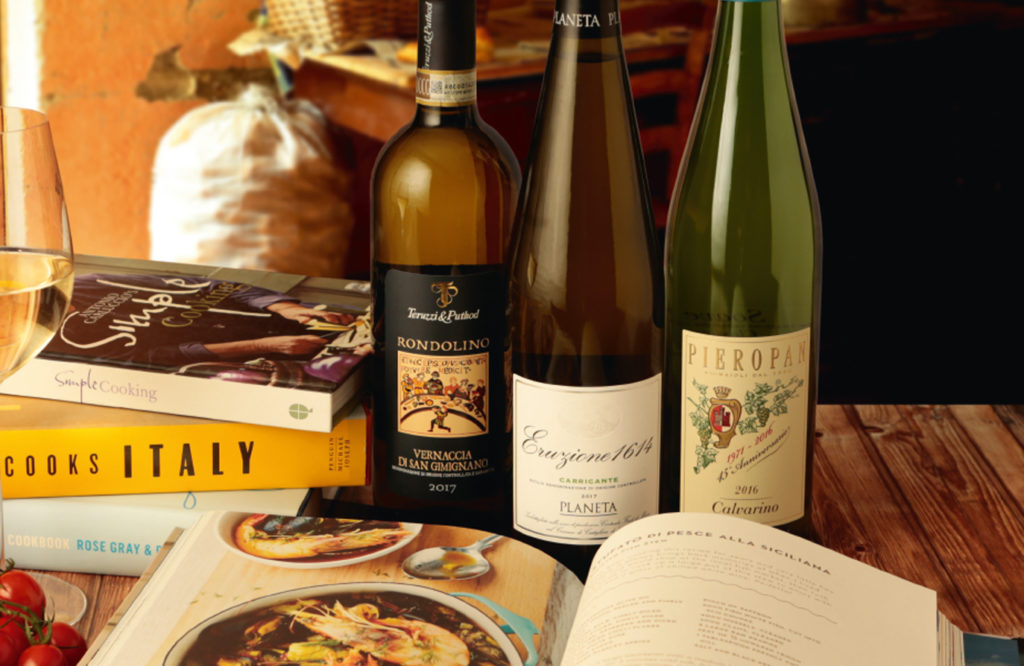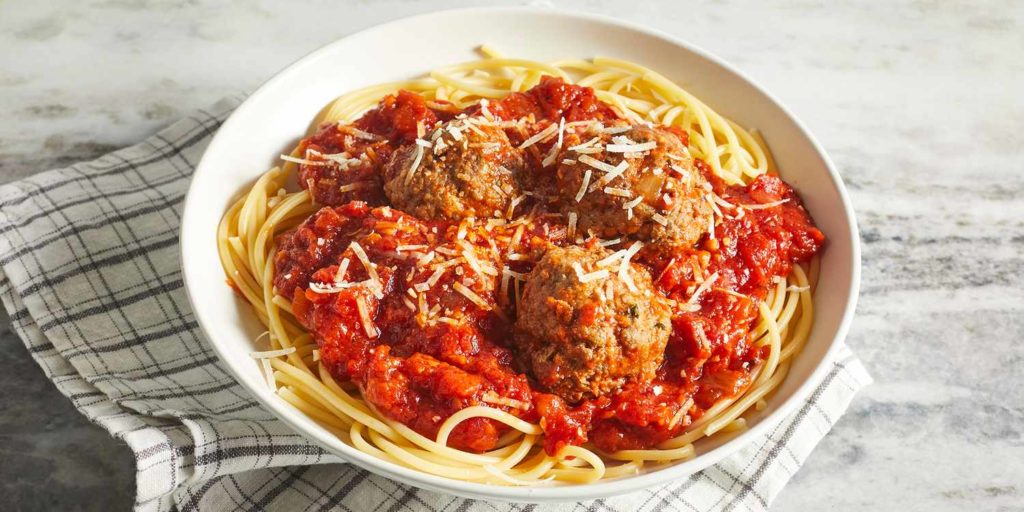Italian cuisine and wine are a good match for a reason: the blend of spices, herbs, and sauces mixed with silky, full-bodied reds or aged, acidic whites produces a dining experience that’s difficult to top.
But how do you know whether your Italian food and wine pairing menu is the perfect complement? Our article about the best wine for Italian food will give you further information to help you select the best menu.
Overview of Italian Food and Wine Pairing
The idea behind wine matching is to balance the tastes of the wine and the dish that you are enjoying. This is true for all varieties of food, from sour to sweet meals.
A wine and food match will occasionally enhance the tastes and qualities of the dish. Sometimes, a wine match balances the dish by enhancing it with opposing flavors and qualities.

If there is a sauce on the meal, it is preferable to choose a wine that will go well with it when choosing the best wine to pair with Italian food. Proteins like beef, poultry, or shellfish can be combined with wine, but if the protein is also served with a tasty sauce, that should be taken into account.
Similar to milk and cookies, Italian cuisine and wine go together. The majority of typical Italian foods pair nicely with red wine, however, certain particular Italian recipes pair beautifully with white wine. And as an extra benefit, sweet dessert wines and Italian sweets go great together!
If done properly, pairing Italian cuisine and wine will significantly improve the tastes, textures, and overall experience. Consider the wine’s acidity, sweetness, and tannins as well as the components of the meal you will soon be eating. Various Italian meals use red wine and white wine as an ingredient!
It’s simple to mix two Italian foods and wines, and the results will probably be satisfying. An excellent Italian meal and wine match is truffles and Barbaresco. Ossobuco, a kind of roast veal from Tuscany, is another well-known food and wine pairing from Italy.
Best wine for Italian food
1. Best red wine with Italian food
- CHIANTI:
Chianti goes well with meaty Italian foods with tomato-based sauces such as Spaghetti, Lasagna, Chicken Parmesan, and Pizza.
Chianti Classico is packed with the delicious, fresh flavors of strawberries, plums, and red and black cherries. The flavors of smoke, soil, herbs, and spices can be tasted in Chianti Classico, which also exudes a rustic charm. With its acidity and tannin, Chianti complements meat and sauce made with tomatoes.
Normally, tannin and tomato sauce don’t mix, but because Chianti has a high acidity level, it has adequate acidity to get along with tomato-based foods.
- BAROLO:
Barolo is very fragrant and contains high levels of acid, tannin, and alcohol. Because of this, Barolo must meet its match.
The foods that combine well with Barolo need to be substantial meals that have a high fat content, such as lard or butter, an acidic ingredient, such as tomatoes, and/or a protein, such as meat or cheese.
Red berries, tar, chocolate, coffee, earth, and roses may all be detected in the scents of Barolo. It has flavors of cinnamon, licorice, raspberry jam, and leather.
- CABERNET SAUVIGNON:
Local Italian cafés frequently offer Cabernet sauvignon as a choice. They have a rich taste and a lot of dark berry flavors. You could even detect hints of bell pepper and black.
Rich red wines like Cabernet Sauvignon go particularly well with the majority of red sauces on pizza and pasta that are made with tomatoes. The wine has a reputation for going well with rich red meats including sirloin, ribeye, and rump steaks.
- MALBEC:
French red wine Malbec is one of the best reds to mix with Italian cuisine. With chicken and pasta and meatballs, it pairs well. It is renowned for having a smokey finish and blackberry taste.
Malbec is a fantastic substitute for Cabernet Sauvignon, which is more costly. Malbec typically tastes like cherries, blackberries, and plums.
- BARBERA:
One of the traditional red wines to combine with Italian cuisine is this robust red wine. It goes nicely with almost any pasta meal, sausage-topped pizza, dark meat dishes, and mushroom risotto.
It is the 3rd most often planted red grape type in Italy, where it is of Italian provenance. Cherry, strawberry, and raspberry tastes can be found in barbera along with a faint wine flavor.
2. Best white wine with Italian food
- PINOT GRIGIO:
Light foods that combine well with Italian Pinot Grigio include mussels, fish, prosciutto, sushi, chicken parmesan, salad, and antipasto. A dry white wine from Italy, Pinot Grigio has strong acidity and mellow flavors of pear, lemon, and mineral.
The fact that Pinot Grigio is so delicate in its approach is what makes it so well-liked. Your glass won’t have any unpleasant or overpowering flavors that would make you think you were drinking wine. With this wine, you’ll never experience any odd yeast, petrol, or stale butter flavors.
- CHARDONNAY:
Any meal with cream in Italy needs a flirty chardonnay. Chardonnay goes well with anything that uses lighter meat, including chicken or shellfish, such as Alfredo recipes. If you don’t think of yourself as a wine aficionado, chardonnay is an excellent wine to buy since it has a pleasant flavor that won’t overpower your taste buds.
Among white wines, chardonnay is frequently served with Italian cuisine. This is because Chardonnay is well-known for having a wide range of tastes. If grown in warmer climes, the grape can release the taste of tropical fruits including papaya, mango, and pineapple. The Chardonnay grape produces bursts of apple, peach, and pears flavors in colder climates.
- SAUVIGNON BLANC:
It is famous for being crisp, elegant, and fresh; nevertheless, the flavor can range from harshly grassy to pleasantly tropical, depending on the environment in which it was grown.
Sauvignon Blanc goes nicely with foods that contain spices like rosemary, basil, parsley as well as mint since it is more savory than other white wines. Sauvignon Blanc would be a perfect match to shellfish or chicken and turkey at an Italian restaurant.
- RIESLING:
Rieslings, according to some, are a fantastic choice for those who like salty or spicy foods. Because of this, it is the preferred wine for Indian cuisine and also one of the best wines for fans of Italian cuisine. Rieslings are a bit of an unexpected white wine choice for an Italian lunch because they are often renowned for going well with fairly light cuisine.
However, their fresh, crisp flavor makes them ideal for baked fish as well as light pasta primavera meals. With the perfect Riesling, rich risottos, creamy-filled shells, and many other dishes also taste fantastic. All things considered, it’s a fantastic white wine for occasions when you are looking to savor the cheesy richness of Italian cuisine.
- EXTRA BRUT CHAMPAGNE:
White wines also include sparkling wines. Champagne is a fantastic pairing for practically any type of meal, but how effectively it works in pairing with the dish depends entirely on how dry or sweet the particular bubbly is.
One of the greatest white wines to mix with Italian cuisine is Extra Brut Champagne. Italian cuisine is incredibly popular with seafood, poultry, and raw bar foods, all of which combine incredibly well with Extra Brut’s dryness. Most champagnes also go nicely with meat and pizzas with red sauce.
10 Best Italian Recipes and wine pairing
1. Chianti with Spaghetti and Meatballs:
Because Chianti pairs well with meatballs and spaghetti sauce, it was associated with spaghetti restaurants back then and during the 1980s. Chianti has a lot of acidity, so it won’t conflict with the tomato-based sauce. Instead, the acidity of the sauce made with tomatoes is complemented by the wine’s bright fruity flavors.

The herbaceous, earthy, and smokey flavors of Chianti Classico, however, go well with any herbs in your meatballs or tomato sauce. The medium to high level of tannin in Chianti Classico is further mellowed by the protein found in your meatballs. The meatballs’ proteins are also broken down by the tannin, giving them a more savory and wonderful flavor.
2. Barolo and Chestnut Gnocchi with Gorgonzola Cream Sauce:
Who says Barolo and vegetarian cuisine don’t go together? The Piemonte area has a large chestnut population. A plate of chestnut gnocchi will highlight Barolo’s more subdued nutty characteristics. One of the most popular types of cheese in Piemonte is gorgonzola. This meal has just the right amount of weight from the heavy cream addition to balance up a robust Barolo.
3. Dolcetto and Pasta Bolognese:
The Bolognese Sauce must include a sizable proportion of tomato sauce for it to go well with pasta Bolognese and Dolcetto. A too-meaty Bolognese sauce won’t go well with Dolcetto since it has a medium body and medium tannin.
For meatier Bolognese sauces, choose a full-bodied Barolo or Chianti Classico. A bottle of Dolcetto can include blueberries, cherries, plums, and other tart fruit flavors that would mix nicely with the sauce’s tomato base. When combining anything with tomato, acidity is crucial. In the meanwhile, the delicate licorice and coffee flavors in Dolcetto give this wonderful pasta dish a hint of rustic appeal.
4. Sangiovese and pasta or risotto:
With anything Italian, including tomato-based sauces, pizza, pasta, and all those rustic garden herbs, Sangiovese is a wine that just shines. Sangiovese and mushrooms get along particularly well; a silky mushroom risotto is a union made in heaven. The matching potential is maintained by the tannic structure and acidity of Sangiovese. Due to its acidity and savory nature, anything that has a strong tomato flavor will work nicely.
5. Pinot Grigio and Chicken Parmesan:
Since chicken parmesan is well-known to be creamy and delicious, Pinot Gris, on the other hand, is a zesty wine with a pleasant acidity level that makes it perfect for meat-based recipes. Indeed, lighter and sweeter wines are frequently served with cheese, but who would have thought that Pinot Noir would enhance the cheese experience?
6. Sauvignon Blanc & Herbed Lemon Chicken:
Highly acidic Sauvignon Blanc is a great match for chicken since it will enhance the delicate fowl flavors in your chicken. Any dryness of the fowl is readily concealed by the crisp flavors of Sauvignon Blanc, providing for a better feast. Any herbs thrown into your chicken recipe will be complemented by the aromatic and green flavors of Sauvignon Blanc.
Finally, whatever vegetable side dishes you serve with your chicken, such as asparagus, salad, or a mix of roasted bell peppers and zucchini, will go well with Sauvignon Blanc. Consequently, a sip of Sauvignon Blanc can make the dish taste more thrilling if you are eating healthfully. Sauvignon Blanc usually pairs well with chicken, regardless of how it is prepared or seasoned.
7. Pinot Grigio and Spaghetti alle Vongole:
An Italian meal called spaghetti alle vongole consists of spaghetti with mussels and a white wine sauce. Spaghetti alle Vongole pairs well with Pinot Grigio because of the wine’s acidity, which helps balance out the dish’s heavy usage of olive oil and the high amount of carbohydrates in the spaghetti noodles.
Clams have an acidic, saline flavor, and the crisp Pinot Grigio flavors of peach, pears, and apple swoop in and balance off the clams’ salinity.
The acidity of Pinot Grigio, meanwhile, enhances the flavors of sea-kissed clams. This crisp wine, which has a light to medium body, won’t dominate the flavorful clams in Spaghetti alle Vongole.
8. Chianti and Bruschetta:
The greatest wine to combine with Bruschetta is Chianti. Chianti Classico pairs beautifully with bruschetta prepared in the traditional manner, which involves tossing garlic, herbs, and tomatoes in olive oil before spreading them on a warm piece of bread.
Although Bruschetta is frequently considered an appetizer or a starter, it is also served as a main dish. Because Chianti Classico has a high acid content, the wine complements tomatoes rather than competing with them. Your olive oil spread’s garlic and herbs compliment the herbaceous and smokey flavors of Chianti.
9. Barolo and Wild Boar Ragù:
A traditional Italian pasta sauce called ragù is made with ground beef, tomatoes, garlic, onions, and red wine. Ragù is a lot like pasta Bolognese in that the beef flavor predominates over the tomato-based sauciness.
Due to its strong tannin and acidity, Barolo is the ideal red wine to pair with ragù sauce since it will complement the meat and won’t conflict with the tomato sauce’s high acidity. The sweet but smoky flavors of the boar flesh are complemented by the smokey river that runs through Barolo.
10. Chardonnay and Pasta Alfredo Sauce:
The ideal wine to combine with Alfredo sauce is a full-bodied Chardonnay because of the wine’s buttery flavors and creamy texture, which balance the sauce’s richness.
Meanwhile, the sauce will be cut through by the Chardonnay’s crisp apple, pear, and lemon flavors, highlighting the nutty pasta flavors.
Additionally, chardonnay has nutty flavors that go well with the nuttiness of parmesan cheese and fresh pasta.
You might also like:
- Do You Put Red Wine in A Wine Cooler?
- Is Igloo a Good Cooler? – Find Out What the Experts Say
- Common Problems With Wine Coolers | Reasons and Solutions
FAQs
1. Does Italian cuisine pair better with red or white wine?
The majority of typical Italian foods pair wonderfully with red wine, however, certain particular Italian recipes pair beautifully with white wine. Additionally, sweet dessert wines and Italian sweets go nicely together!
2. What exactly is a wine-matching menu?
A menu that makes it simple for customers to enjoy intelligent meal and wine pairings is known as a food and wine matching menu. It may be almost any kind of menu. In different ways, too. It might also imply pairing a certain wine with a particular food.
3. Does wine accompany meals in Italy?
Except for pizza, which is generally paired with beer, Italians prefer to drink wine instead of beer or beverages with meals.
4. Why do Italians pair their pasta with wine?
Italians often don’t pre-drink their glasses of wine before the pasta dish is served since the wine is intended to enhance the meal. In more sentimental Italian, you would say they were intended to be together.
5. What are the fundamental guidelines for combining wine and food?
There are two approaches to wine and food pairing. A wine can be chosen to go with food in a complimentary match, or a wine might be consumed to improve a dish in a congruent pairing.
Conclusion
With a greater grasp of the finest wines that go well with a suitable Italian dish, you can enhance the flavor and perfectness of that dish and also have a cheerful time enjoying the dish too. Italian pasta sauces, barbecued meats, veggies, and mouthwatering cheeses all go great with a range of wines.
Always drink what you truly appreciate, whether you’re having dinner in your house or at an Italian restaurant, keep our pairings in Best Wine for Italian Food in mind.

With over a decade of experience in viticulture, Simon Conner is the perfect writer to help you find and maintain your prized vintages. As an expert on food, wine, and kitchen products, he offers his expertise to guide clients through every step involved with collecting and selling wines.

